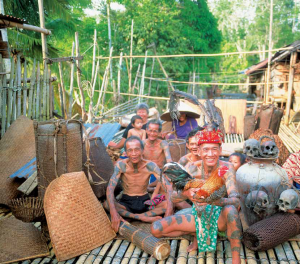The jungle gives way to domestic life as we climb the steps to the longhouse, just a few steps from the wide swift river that has carried us here.
Chickens peck around the stairs, piglets squeal and hide, cats stalk past, and half a dozen assorted dogs look up lazily from the sunny spots they’ve found on what at first appears to be a wide, covered veranda.
Flashing smiles welcome us to the longhouse, home to an entire village. Fourteen doorways line one side of the veranda and from them emerge members of most of the 14 families who live here.
This is Sarawak, one of four states which make up the world’s third largest island – Borneo – and once the home of fierce tribes of head-hunters. But modern life has reached even these remote spots, with longhouses now open to visitors either on day trips or in some cases, overnight stays.
We have travelled from Sarawak’s capital, Kuching, starting with a four-hour drive along the Pan-Borneo Highway. The largest of Malaysia’s 13 states, Sarawak covers 125,000 sq km and is home to more than 25 different ethnic groups, the largest of which is the Iban.
It’s a long way from the sleepy vibe of Kuching – and even further from the bustle of the vibrant modern Malaysian capital, Kuala Lumpur – known to all as just KL. These three places alone speak to the diversity of Malaysia, and the reason that so many Australians keep coming back for more.
In KL, ancient traditions and gleaming modern skyscrapers have much to offer tourists and shoppers. To see it all at once, we go for a bird’s-eye view of the city, a trip to the 41st floor of the striking steel-andglass Petronas Twin Towers in the Kuala Lumpur City Centre. While you are not quite half-way up these 88-story towers – once the tallest buildings in the world – you are on a “skybridge” between them at 170 metres. To go further, head for the Observation Deck at 360 metres on the 86th floor!
Back on the ground, I discover the need to brush up on my bargaining skills when I head to the heart of Kuala Lumpur’s original Chinatown, Petaling Street, for some serious haggling over the best buys.
The pre-war shophouses are open throughout the day but after 6pm the lanterns are lit and the Pasar Malam (night market) takes over. Here you’ll find stalls selling everything from fresh produce to hot snacks and dried food, herbal remedies, clothing, toys, jewellery, and trinkets. Designer knock-offs – handbags, hats, t-shirts and more – abound.
The atmosphere is steamy, noisy and lively. Wind your way through the maze of stalls and be prepared to haggle hard. While you can buy almost anything, half the fun is just in wandering through the melee enjoying the sights, sounds and energy.
For gentler pursuits, take a stroll in KL’s Perdana Botanical Garden (also called the Lake Gardens). Created in the 1880s around an artificial lake, the gardens cover 92 hectares and include a number of attractions.
The Orchid Garden showcases 800 species from Malaysia and on weekends becomes a lively bazaar selling plants and flowers. You can also visit the Deer Park, home to the world’s smallest hoofed animal, the mousedeer. There is also a children’s playground, jogging tracks, rowing boats and a small hibiscus garden.
Adjacent to the botanical garden is the Kuala Lumpur Butterfly Park, with around 6000 butterflies of more than 120 species in a Malaysian rainforest setting, and Bird Park, the largest in south-east Asia.
Carcosa Seri Negara, a pair of British colonial mansions set in a 16-hectare garden above the Lake Garden, is the perfect spot for a traditional English high tea, served daily in the elegant drawing room or on the verandah overlooking the gardens.
Built in 1896, Carcosa was the official residence for Britain’s highest-ranking officials from 1904 to 1941. With the independence of Malaya in 1957, it became the residence of the British High Commissioner and in 1987 it was returned to the Government of Malaysia.
Seri Negara was the guesthouse for Malaysia’s most important visitors – including Queen Elizabeth II. Since 1989, both mansions have been run jointly as an exclusive boutique hotel.
Outside the cities, Malaysia is sometimes called “the Amazon of Asia” for its abundant wildlife, including elephants, rhinos, tigers, Proboscis monkeys and – what everyone wants to see -– orangutans.
Malaysia is ideally placed as a stopover for anyone heading from Australia to Europe, the Middle East, or anywhere in Asia, and has a diversity of experiences that keeps Australians coming back.



